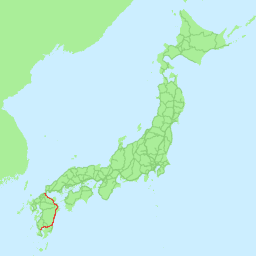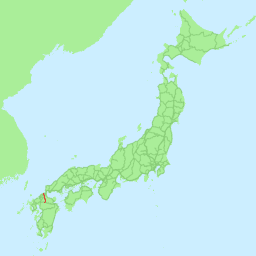|
Jōno Station (JR Kyushu)
is a railway station in Kokura Minami-ku, Kitakyushu, Japan, operated by Kyushu Railway Company (JR Kyushu). Lines Jōno Station is served by the Nippō Main Line as well as the Hitahikosan Line, of which it is the northern terminus. Passenger statistics In fiscal 2016, the station was used by an average of 4,276 passengers daily (boarding passengers only), and it ranked 48th among the busiest stations of JR Kyushu. See also *List of railway stations in Japan The links below contain all of the 8579 railway stations in Japan. External links {{Portal bar, Japan, Trains * Railway stations Japan Japan ( ja, 日本, or , and formally , ''Nihonkoku'') is an island country in East Asia. It ... References External links * Railway stations in Fukuoka Prefecture Buildings and structures in Kitakyushu Railway stations in Japan opened in 1895 {{Fukuoka-railstation-stub ... [...More Info...] [...Related Items...] OR: [Wikipedia] [Google] [Baidu] |
Kokuraminami-ku, Kitakyūshū
is a ward of Kitakyūshū, Fukuoka, Japan. It is the southern part of what used to be Kokura City, which was merged into Kitakyūshū city when the latter was created out of the merger of five cities in 1963. At this time Kokura was divided into North and South wards. Kokuraminami ward is mainly rural and undeveloped, and includes the Hiraodai karst plateau and Sugao no taki (waterfall). However, it also includes the present airport and the airport buildings of the new Kitakyūshū Airport, and Shimosone shopping mall. Population (2000 national census): 213,741 Area: 170.25 km² (includes northern part of the new airport island) Economy StarFlyer has its headquarters on the grounds of Kitakyūshū Airport in Kokuraminami-ku. " |
Kitakyushu
is a Cities of Japan, city located in Fukuoka Prefecture, Japan. As of June 1, 2019, Kitakyushu has an estimated population of 940,978, making it the second-largest city in both Fukuoka Prefecture and the island of Kyushu after the city of Fukuoka. It is one of Japan's 20 Cities designated by government ordinance of Japan, designated cities, one of three on Kyushu, and is divided into seven Wards of Japan, wards. Kitakyushu was formed in 1963 from a merger of municipalities centered on the historic city of Kokura, and its name literally means "North Kyushu City" in Japanese. It is located at the northernmost point of Kyushu on the Kanmon Straits, separating the island from Honshu, across from the city of Shimonoseki. Kitakyushu and Shimonoseki are connected by numerous transport links including the Kanmon Bridge and the Kanmon Tunnel (other), Kanmon Tunnels. Kitakyushu's Urban Employment Area forms part of the Fukuoka-Kitakyushu, Fukuoka-Kitakyushu Greater Metropolitan ... [...More Info...] [...Related Items...] OR: [Wikipedia] [Google] [Baidu] |
Fukuoka Prefecture
is a Prefectures of Japan, prefecture of Japan located on the island of Kyūshū. Fukuoka Prefecture has a population of 5,109,323 (1 June 2019) and has a geographic area of 4,986 Square kilometre, km2 (1,925 sq mi). Fukuoka Prefecture borders Saga Prefecture to the southwest, Kumamoto Prefecture to the south, and Ōita Prefecture to the southeast. Fukuoka is the capital and largest city of Fukuoka Prefecture, and the largest city on Kyūshū, with other major cities including Kitakyushu, Kurume, and Ōmuta, Fukuoka, Ōmuta. Fukuoka Prefecture is located at the northernmost point of Kyūshū on the Kanmon Straits, connecting the Tsushima Strait and Seto Inland Sea across from Yamaguchi Prefecture on the island of Honshu, and extends south towards the Ariake Sea. History Fukuoka Prefecture includes the Old provinces of Japan, former provinces of Chikugo Province, Chikugo, Chikuzen Province, Chikuzen, and Buzen Province, Buzen. Shrines and temples Kōra taisha, Sumiyoshi-jinja, ... [...More Info...] [...Related Items...] OR: [Wikipedia] [Google] [Baidu] |
Island Platforms
An island platform (also center platform, centre platform) is a station layout arrangement where a single platform is positioned between two tracks within a railway station, tram stop or transitway interchange. Island platforms are popular on twin-track routes due to pragmatic and cost reasons. They are also useful within larger stations where local and express services for the same direction of travel can be provided from opposite sides of the same platform thereby simplifying transfers between the two tracks. An alternative arrangement is to position side platforms on either side of the tracks. The historical use of island platforms depends greatly upon the location. In the United Kingdom the use of island platforms is relatively common when the railway line is in a cutting or raised on an embankment, as this makes it easier to provide access to the platform without walking across the tracks. Advantages and tradeoffs Island platforms are necessary for any station with many th ... [...More Info...] [...Related Items...] OR: [Wikipedia] [Google] [Baidu] |
Side Platform
A side platform (also known as a marginal platform or a single-face platform) is a platform positioned to the side of one or more railway tracks or guideways at a railway station, tram stop, or transitway. A station having dual side platforms, one for each direction of travel, is the basic design used for double-track railway lines (as opposed to, for instance, the island platform where a single platform lies between the tracks). Side platforms may result in a wider overall footprint for the station compared with an island platform where a single width of platform can be shared by riders using either track. In some stations, the two side platforms are connected by a footbridge running above and over the tracks. While a pair of side platforms is often provided on a dual-track line, a single side platform is usually sufficient for a single-track line. Layout Where the station is close to a level crossing (grade crossing) the platforms may either be on the same side of the cross ... [...More Info...] [...Related Items...] OR: [Wikipedia] [Google] [Baidu] |
Kokura Minami-ku, Kitakyushu
is an ancient castle town and the center of Kitakyushu, Japan, guarding the Straits of Shimonoseki between Honshu and Kyushu with its suburb Moji. Kokura is also the name of the penultimate station on the southbound San'yō Shinkansen line, which is owned by JR West. Ferries connect Kokura with Matsuyama on Shikoku, and Busan in South Korea. History Edo period The Ogasawara and Hosokawa clans were ''daimyō'' at Kokura Castle during the Edo period (1603–1868). Miyamoto Musashi, samurai swordsman, author of ''The Book of Five Rings'' and founder of the Hyoho Niten Ichi-ryū, famous for its use of two swords, lived in the Kokura castle under the patronage of the Ogasawara and Hosokawa clans briefly during 1634. Meiji period After the end of the Tokugawa Shogunate, Kokura was the seat of government for Kokura Prefecture. When the municipal system of cities, towns and villages was introduced, Kokura Town was one of 25 towns in the prefecture, which later merged with ... [...More Info...] [...Related Items...] OR: [Wikipedia] [Google] [Baidu] |
Kyushu Railway Company
The , also referred to as , is one of the seven constituent companies of Japan Railways Group (JR Group). It operates intercity rail services within Kyushu, Japan and the JR Kyushu Jet Ferry Beetle hydrofoil service across the Tsushima Strait between Fukuoka and Busan, South Korea. It also operates hotels, restaurants, and drugstores across its service region. JR Kyushu's headquarters are in Hakata-ku, Fukuoka. ." Kyushu Railway Company. Retrieved on March 27, 2010. History When was divided in 1987, Kyushu Railway Company inherited its assets and operations on the island of |
Nippō Main Line
The is a railway line in Kyushu, in southern Japan, operated by Kyushu Railway Company (JR Kyushu). The line connects Kokura Station in Kitakyushu, Fukuoka, and Kagoshima Station in Kagoshima via the east coast of Kyushu, passing through the prefectural capitals of Ōita and Miyazaki. A number of Limited Express trains operate along the route, including Limited Express Sonic trains between Hakata and Oita. Stations :●: Stops :▲: Rapid service connecting to Hitahikosan Line non-stop, :|: Non-stop :Liner services: ''Sawayaka Liner'', ''Home Liner'' Though Kagoshima is the southern terminus for the line, some trains continue via the Kagoshima Main Line to the adjacent Kagoshima-Chūō station. History The Kyushu Railway Co. opened the 6 km Kokura - Jono section in 1895, and the Hōshū Railway Co. opened the 46 km Yukuhashi - Buzen Nagasu section in 1897. The former company acquired the latter in 1901, and was nationalised in 1907. The lines were connected ... [...More Info...] [...Related Items...] OR: [Wikipedia] [Google] [Baidu] |
Hitahikosan Line
The is a railway line in Japan, operated by Kyushu Railway Company (JR Kyushu). It connects Jōno Station in Kitakyushu, Fukuoka Prefecture with Yoake Station in Hita, Ōita Prefecture and features the 4380 m Shakadake Tunnel between Chikuzen Iwaya and Hikosan station, where a fatal tunnel collapse occurred during construction in 1953, killing 21 construction workers. The line is named after Hita and Mount Hiko. Stations :●: Stops, |: non-stop History The Toyo-shu Railway Co. opened the Tagawa-Ita - Buzen Kawasaki section as part of the Tagawa Line in 1899. That company merged with the Kyushu Railway Company in 1901, which extended the line to Soeda in 1903. The company was nationalised in 1907. The Jono - Tagawa-Ita section was opened in 1915 by the Kokura Railway Co., that company being nationalised in 1943. The Soeda - Daigyoji section opened between 1937 and 1946, and the Daigyoji - Yoake section opened in 1956. CTC signalling was introduced on the entire line in 1 ... [...More Info...] [...Related Items...] OR: [Wikipedia] [Google] [Baidu] |
List Of Railway Stations In Japan ...
The links below contain all of the 8579 railway stations in Japan. External links {{Portal bar, Japan, Trains * Railway stations Japan Japan ( ja, 日本, or , and formally , ''Nihonkoku'') is an island country in East Asia. It is situated in the northwest Pacific Ocean, and is bordered on the west by the Sea of Japan, while extending from the Sea of Okhotsk in the north ... [...More Info...] [...Related Items...] OR: [Wikipedia] [Google] [Baidu] |
Railway Stations In Fukuoka Prefecture
Rail transport (also known as train transport) is a means of transport that transfers passengers and goods on wheeled vehicles running on rails, which are incorporated in tracks. In contrast to road transport, where the vehicles run on a prepared flat surface, rail vehicles (rolling stock) are directionally guided by the tracks on which they run. Tracks usually consist of steel rails, installed on sleepers (ties) set in ballast, on which the rolling stock, usually fitted with metal wheels, moves. Other variations are also possible, such as "slab track", in which the rails are fastened to a concrete foundation resting on a prepared subsurface. Rolling stock in a rail transport system generally encounters lower frictional resistance than rubber-tyred road vehicles, so passenger and freight cars (carriages and wagons) can be coupled into longer trains. The operation is carried out by a railway company, providing transport between train stations or freight customer faciliti ... [...More Info...] [...Related Items...] OR: [Wikipedia] [Google] [Baidu] |
Buildings And Structures In Kitakyushu
A building, or edifice, is an enclosed structure with a roof and walls standing more or less permanently in one place, such as a house or factory (although there's also portable buildings). Buildings come in a variety of sizes, shapes, and functions, and have been adapted throughout history for a wide number of factors, from building materials available, to weather conditions, land prices, ground conditions, specific uses, prestige, and aesthetic reasons. To better understand the term ''building'' compare the list of nonbuilding structures. Buildings serve several societal needs – primarily as shelter from weather, security, living space, privacy, to store belongings, and to comfortably live and work. A building as a shelter represents a physical division of the human habitat (a place of comfort and safety) and the ''outside'' (a place that at times may be harsh and harmful). Ever since the first cave paintings, buildings have also become objects or canvasses of much artistic ... [...More Info...] [...Related Items...] OR: [Wikipedia] [Google] [Baidu] |






